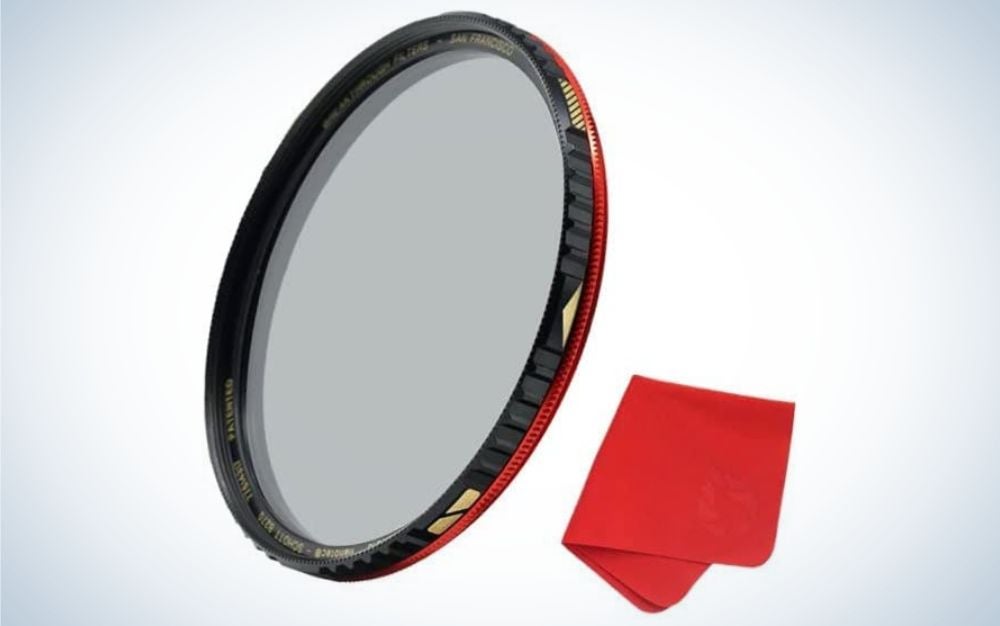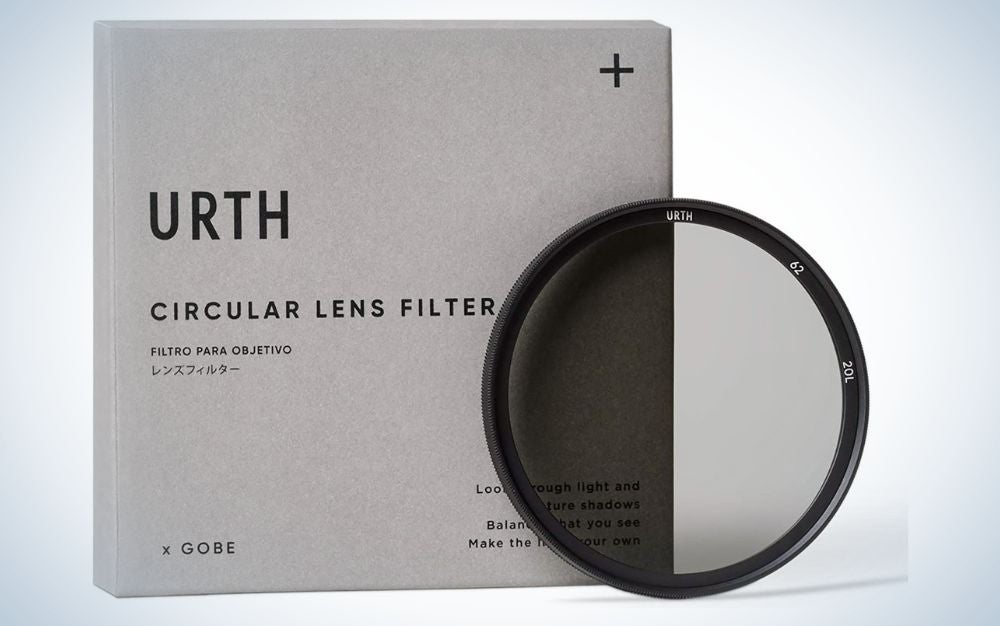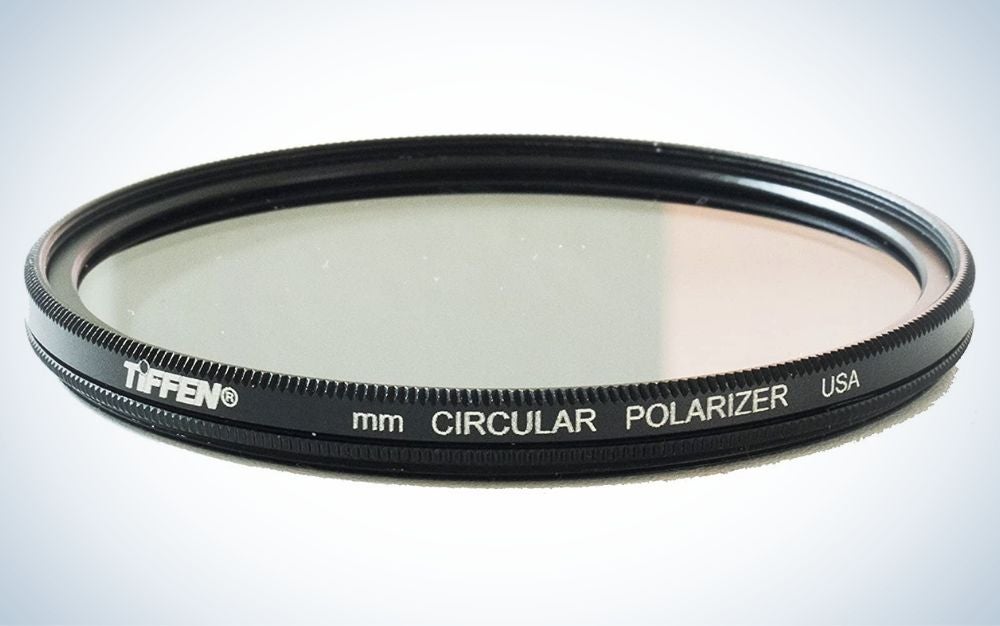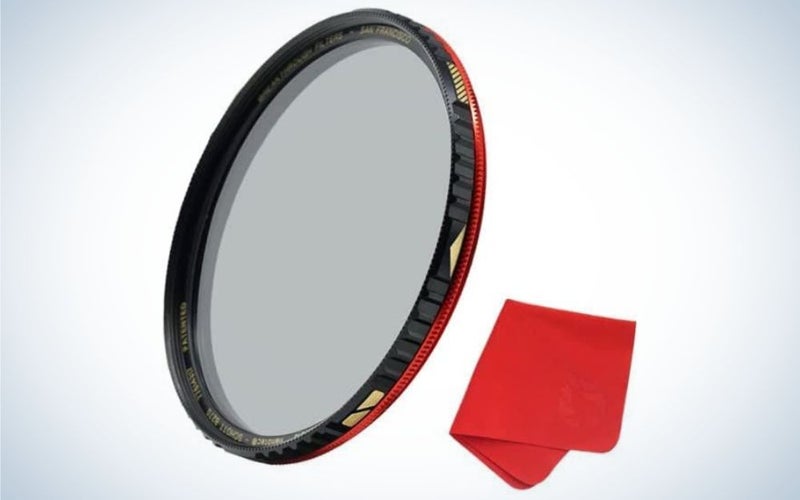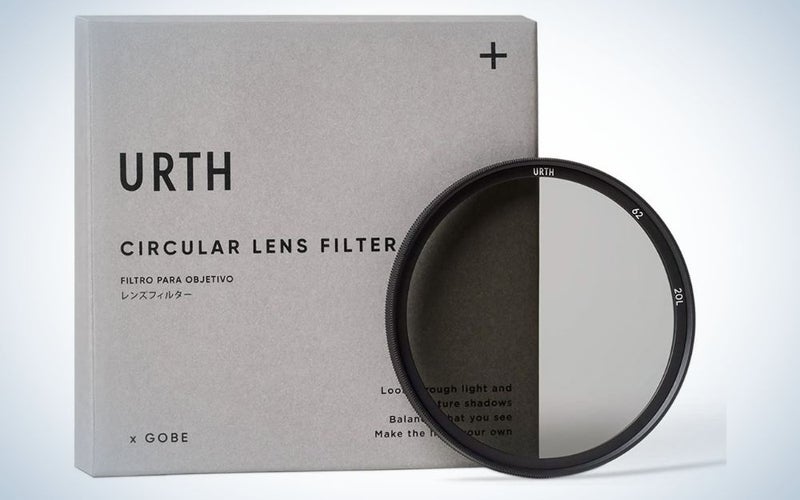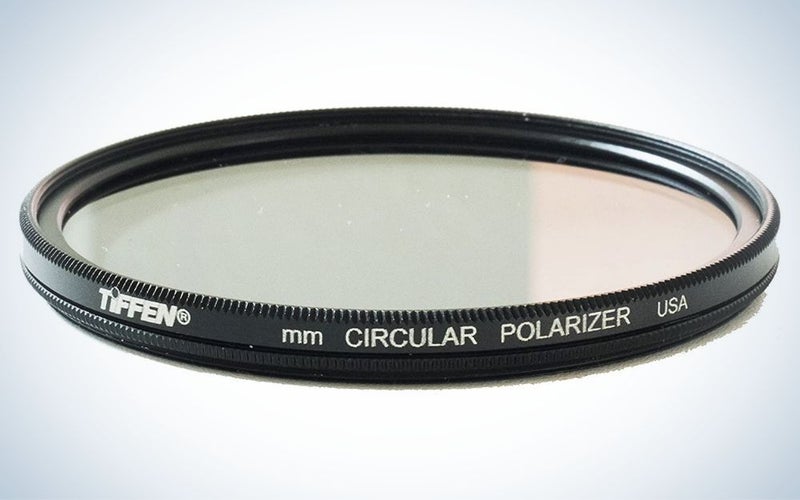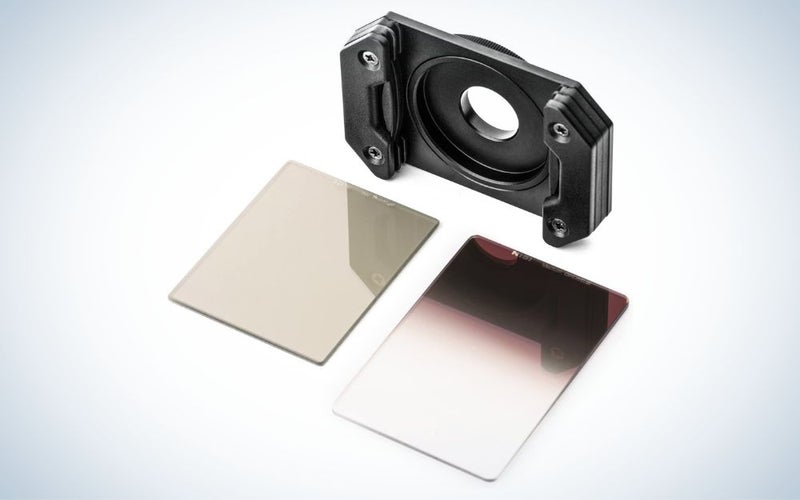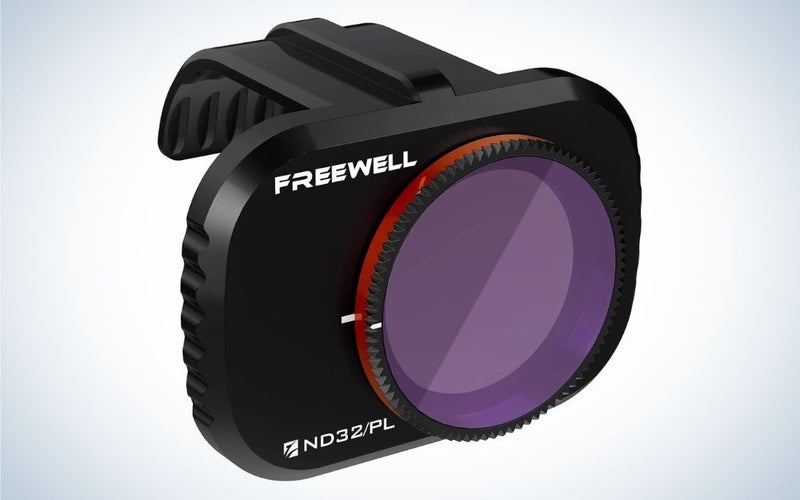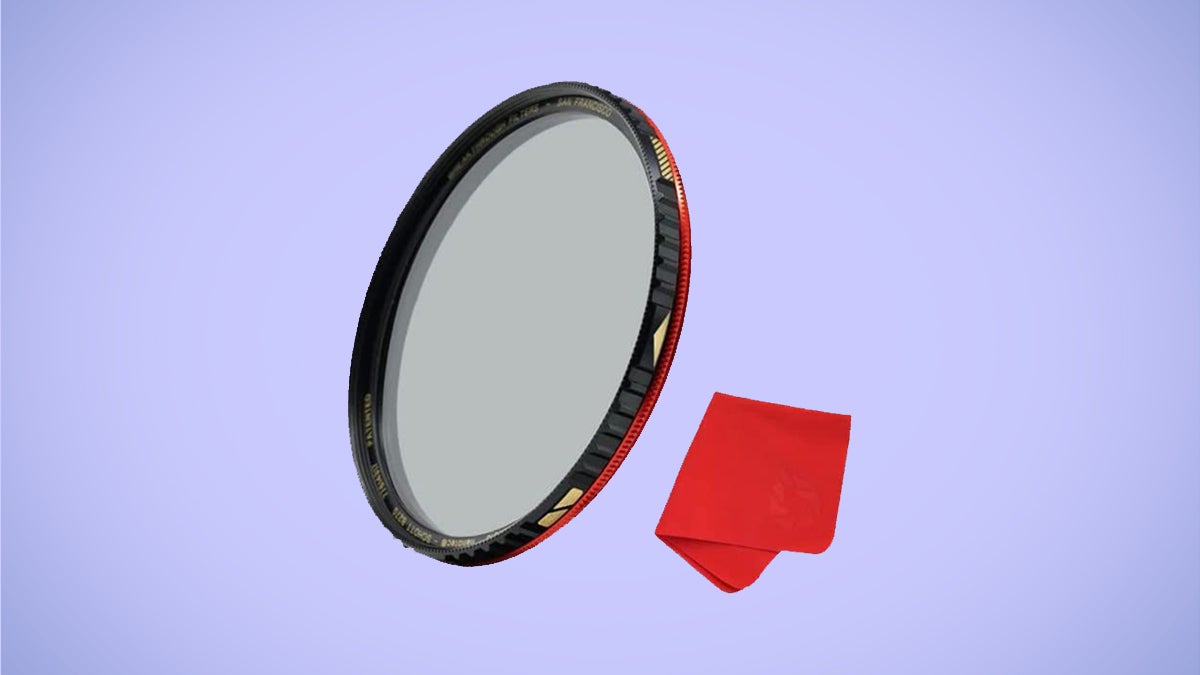
We may earn revenue from the products available on this page and participate in affiliate programs. Learn more ›
Polarizing filters are an integral part of photography. It can increase contrast and color saturation simply by reducing the reflections coming from shiny surfaces. As a result, things tend to look more appealing and less washed out with polarizers.
Polarizers are notoriously essential for landscape photographers. But you shouldn’t ignore them in portraiture, architecture, sports, product, or any other photographic discipline where reflective surfaces will be present. The benefit of a circular polarizer is that you can rotate the front of the filter to dial in the desired amount of filtration, allowing for ultimate creative control over your images. With the best polarizing filters, your photographs will be even better.
- Best overall: Breakthrough Photography X4 CPL
- Best value: Urth CPL Polarizing Filter Plus+
- Best on a budget: Tiffen Circular Polarizers
- Best for mobile: NiSi P1 Prosories Mobile Filter Kit
- Best for drones: Freewell ND/PL Hybrid Filters
Things to consider before buying polarizing filters
A lot of manufacturers intentionally obfuscate the details behind some aspects of their filters. While they likely do this to prevent giving away trade secrets and proprietary recipes and processes, it makes filters harder to recommend because of the lack of transparency in the industry. Although coatings, materials, and filter factor are extremely important to a filter’s usability, some extra added features like knurling, slimness, double threaded rings, color-coded frames, and visual guides are also worth considering.
Coatings
The coatings on polarizing filters are a mix of various chemical compounds sprayed over a polarizer’s front (and sometimes the back). These coatings are designed to improve the polarizer’s overall durability and longevity. Every manufacturer has a proprietary formula and unique name for their specific coatings. Still, generally, they are designed to help repel water, dirt, and oil and also to help protect against scratches. Some polarizers, however, are uncoated, which can drastically reduce the filter’s cost, albeit while reducing its useable lifespan.
Glass type
The glass that makes up the filter itself is important. Any imperfections on the glass will translate to the final image. Many of the top manufacturers are transparent in their use of a German product called Schott B270, which seems to be the industry-leading choice for premium filters. That’s not to say that other types of glass are inferior. For example, Japanese AGC optical glass is also popular in some premium filters. But be wary of manufacturers who either don’t list the specific product or only list optical glass. These filters might not be as good as those whose materials are listed.
Ring material
You may not have ever thought about it, but the materials used in the rim and ring construction of filters actually make a difference, especially if you’re an outdoor photographer. Aluminum is the most common and least expensive metal used in filter construction. But when aluminum screw-on filters get cold, they tend to bind to the front of lenses and other filters, making them extremely difficult to remove unless heat or a breaking force is applied (like with a filter wrench).
Brass has historically been the best choice for screw-on filters as it does not tend to bind like aluminum. But now, manufacturers are using other, more exotic–if unproven–materials like magnalium, and titanium, which both promise enhanced durability while remaining lightweight.
Filter factor
One of the most overlooked factors in deciding on a polarizer is its filter factor. You will always lose a certain amount of light due to using a polarizing filter. The specific amount is called the “filter factor.” It is most often referred to by a number by which the normal exposure time must be multiplied to compensate for the use of that specific filter. For example, a polarizer with a filter factor of 2x requires twice as much exposure–or 1-stop–to make the same image with a polarizer as without.
The lower the filter factor, the less light is absorbed by the filter, and thereby less compensation is needed to achieve similar results from not using a filter. Most photographers prefer a polarizer with the lowest filter factor possible, so they don’t have to compromise too much with aperture, shutter speed, or ISO settings.
Here are our picks for the best polarizing filters in 2022
Best overall: Breakthrough Photography X4 CPL
Breakthrough Photography
Why it made the cut: It is best in class in light transmission, color neutrality, materials, and features, all while maintaining affordability for a premium polarizer.
Key features
- Coatings: 8-layer multi-resistant coating
- Glass type: Schott Superwhite B270
- Ring material: Brass
- Filter factor: 2x (+1 stop)
Pros
- Premium materials
- Fastest CPL on the market
- Weather-sealed
- 25-year guarantee
Cons
- A little pricey
Breakthrough Photography might not be a household name in filters, but they should be, especially after getting familiar with their polarizer lineup. The X4 circular polarizers might be the best on the market when considering materials, build quality, and performance.
These X4 polarizers somehow manage to have the lowest filter factor on the market today, losing only one stop of light. And they retain a near-perfect level of color neutrality. If that wasn’t enough, they also are double threaded and super thin, allowing for the use of wide-angle lenses of at least 16mm without vignetting.
But the good news doesn’t stop there. Breakthrough Photography also added a couple of features never seen on circular polarizers but are welcome additions. First are the series of guide symbols on the filter frame, which allows for quick visual checking of the position of the polarizer for the desired amount. The guides are especially useful when switching between vertical and horizontal compositions. Second is the color-coded frame, which helps identify this filter among the endless sea of black filters in your filter pouch. Yes, you will pay a little more for the X4 series of polarizers, but they are absolutely worth the extra cost.
Best value: Urth CPL Polarizing Filter Plus+
Urth
Why it made the cut: It’s a great all-around performer with a nice compromise between materials, performance, and price. Plus, Urth doesn’t use plastic in its packaging and plants five trees with every item sold.
Key Features
- Coatings: 20-layer nano coating
- Glass Type: Schott Superwhite B270
- Ring Material: Magnalium (aluminum magnesium alloy)
- Filter Factor: 2.4x (+1.3 stop)
Pros
- Premium materials
- Admirable performance
- Lifetime warranty
- Eco-conscious
Cons
- Missing knurling on sides
- Magnalium ring may bind to lenses
Urth is a relatively new name in the photographic filter world. Formerly known as Gobe, Urth filters started in 2014 as a brand with an eco focus. All of the products it sells come with the added bonus of planting five trees to help offset deforestation and to revitalize the ecosystems in Madagascar, Nepal, Haiti, Mozambique, and Indonesia.
Urth has priced its Plus+ line of circular polarizers aggressively for premium filters. Urth makes its filters with quality materials, have a lifetime warranty, and come with the positive impact of carbon sequestration and zero plastic waste. They also have a low profile, so you can use them with wide-angle lenses without vignetting. And they are double-threaded to boot, so you can still use your lens cap.
A few nice to-haves are missing from these polarizers, like side knurling on the rotator ring for easy gripping and the lack of brass in the construction. But the low filter factor, use of Schott B270 glass, and multiple layer nanocoatings for added protection are enough to offset its supposed deficiencies. Couple that with the eco-conscious packaging design and company mission, and you have all the makings of incredible value for money. When you consider the use of low-impact and upcycled materials, Urth Plus+ polarizing filters should be on your shortlist the next time you need one.
Best on a budget: Tiffen Circular Polarizers
Tiffen
Why it made the cut: These are the best polarizers for tight budgets. Tiffen is an established brand with a great warranty and US manufacturing.
Key Features
- Coatings: None
- Glass Type: Proprietary ColorCore Glass
- Ring Material: Aluminum
- Filter Factor: 2.3x (+1.2 stop) to 2.8x (+1.5 stop)
Pros
- Respectable performance
- Very budget friendly
- Made in the USA
- 10-year warranty
Cons
- Causes vignetting with wide-angle lenses
- Aluminum ring can bind to lenses
If you need a polarizer but don’t want to spend much on it, look no further than Tiffen’s entry-level circular polarizers. Tiffen is a well-respected manufacturer with over 70 years of experience and has won multiple Academy and Emmy awards for its achievements in filtration. So it should be no surprise that they want your first filter to be a Tiffen. These entry-level polarizers are designed and manufactured in the US and come with an impressive 10-year warranty. And yet they are still some of the least expensive polarizers on the market.
However, there are a few tradeoffs at this price point, most notably the absence of coatings on the glass. The lack of coatings makes them more apt to gather dust, oil, and moisture. Also, aluminum is lightweight and inexpensive but tends to bind to lenses in the cold. Finally, wide-angle shooters will find unwelcome vignetting when using these polarizers below 20mm as they are quite thick. But all of these shortcomings aside, Tiffen is a reputable company that makes excellent filters and, arguably, the best budget polarizers too.
Best for mobile: NiSi P1 Prosories Mobile Filter Kit
NiSi
Why it made the cut: It has universal smartphone camera compatibility with quality NISI glass filters.
Key Features
- Coatings: Optical Nano Coating
- Glass Type: Proprietary Optical Glass
- Ring Material: Aluminum
- Filter Factor: 2x (+1 stop) to 2.8x (+1.5 stop)
Pros
- Universal compatibility
- Affordable
- Doesn’t require a special case
- Superb filter quality
Cons
- Holder and clip can be finicky to mount properly
- Might not be able to use CPL and GND at the same time
The main problem with finding the right polarizer for mobile phones is the complete lack of a uniform industry standard in front lens construction. Just about every mobile camera array is completely different from phone to phone. These often require the purchase of a unique phone case to attach the filters to, which can be more than double the price. The alternative universal clip-on filters are seriously lacking, both in materials and construction. That’s why the NiSi P1 Mobile Filter kit is the pick of the litter.
The P1 Mobile kit comes with a universal mobile mounting clip and filter holder to attach the included polarizing and graduated filters. NiSi manufactures its P1 Prosories using the same high-quality optical glass and coatings as the rest of its product line, albeit in a much smaller size. This enables the P1 kit to be incredibly inexpensive when compared to other mobile filter kits.
The only questionable aspect of this kit is the mobile clip and filter holder assembly. The universal clip-on design means that it’s not excellent at attaching to any specific phone. It’s just average for every phone. Besides that shortcoming, the ability to use the polarizer in combination with the included three-stop graduated neutral density filter on the front or rear-facing cameras is a huge plus. This unique filter kit is the one to check out if you need a circular polarizer for your mobile devices.
Best for drones: Freewell ND/PL Hybrid Filters
Freewell
Why it made the cut: They are the only hybrid filters sold individually or as part of a kit and have superb quality and performance at an affordable price.
Key Features
- Coatings: 16-layer Multi Coating
- Glass Type: German Optical Glass
- Ring Material: Aluminum Alloy
- Filter Factor: 4x (+2 stops) to 64x (+6 stop)
Pros
- Can be bought individually
- Affordable
- Hybrid neutral density and polarization
- Lifetime warranty
Cons
- Risk of gimbal damage due to user error
Finding a circular polarizing filter for a drone is no easy task, especially when most manufacturers only sell drone filters as part of a kit. Thankfully, Freewell offers individual filters for most of the popular drones on the market. Their hybrid ND/PL hybrid filter line combines a neutral density filter with a circular polarizer. It allows for more cinematic footage by slowing down the shutter speed during daytime shooting. Freewell has also added markings to their ND/PL filters for users to quickly visualize where they should set the circular polarizer for the best polarization effect.
These filters are guaranteed to be light enough to not interfere with the fragile gimbal assembly. However, you should note that user error can be a factor anytime one comes into contact with the gimbal. That being said, there’s so much to like about these Freewell drone filters. They are affordable and well constructed using a light aluminum alloy, use German optical glass with multi-layered coatings, and come with a lifetime warranty. But the best feature by far is the ability to purchase any of these filters individually or as part of a kit.
FAQs
Q: What does a polarizing filter do?
A polarizing filter allows you to control the amount of reflected light entering your camera lens. As a result, using a polarizer can reduce reflections from shiny surfaces like water, glass, skin, and vegetation, showing the true colors underneath. It can also darken blue skies, increase color saturation and contrast, and allow for the use of longer shutter speeds due to the tinted nature of the filter.
Q: Do I need a polarizing filter?
If you want to suppress glare and reduce reflections in your photos, you need a polarizing filter. A good rule of thumb is if there’s glass, water, or sky in your desired composition, you could benefit from using a polarizing filter. It’s also critical to mention that a polarizer’s primary function of reducing glare and reflections cannot be reproduced or mimicked in software. However, if you want to see reflections in your scene, you’re shooting rainbows, or are in a dark environment, it’s probably a good idea to leave it off.
Q: Which type of polarizing filter is recommended for most photographers?
For most photographers, a screw-on circular polarizing filter (CPL) is the correct choice. Although linear polarizers are available, they likely won’t work properly with modern camera systems and should be avoided.
Final thoughts on polarizing filters
The effect that a polarizing filter has on your image is something that you cannot recreate using software; thus, it’s an accessory that should be a part of every photographer’s kit. Even the most modestly priced circular polarizers will have a noticeable effect on your images. Of course, the more expensive filters do this too, but they are much sharper and more color neutral. Plus, they’ll perform better in adverse weather conditions and will last longer in the end.
Methodology
There was no one key criteria in determining our favorites when compiling this list of the best circular polarizers. Instead, we considered a number of different factors, including build quality, materials, light transmission, extra features, warranty, and price. We investigated the manufacturers’ spec sheets, read consumer reviews, and drew on our combined experience as photographers using polarizing filters.
The post The best polarizing filters in 2023 appeared first on Popular Photography.
Articles may contain affiliate links which enable us to share in the revenue of any purchases made.
